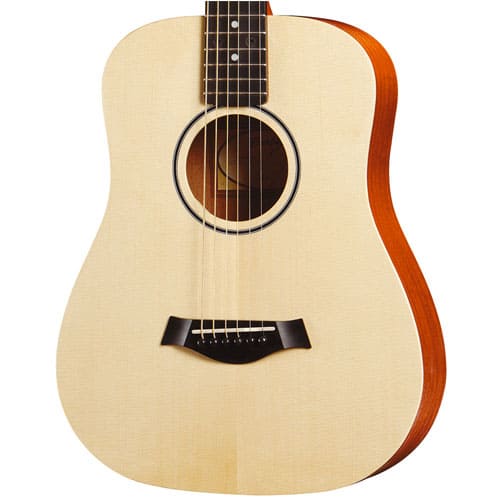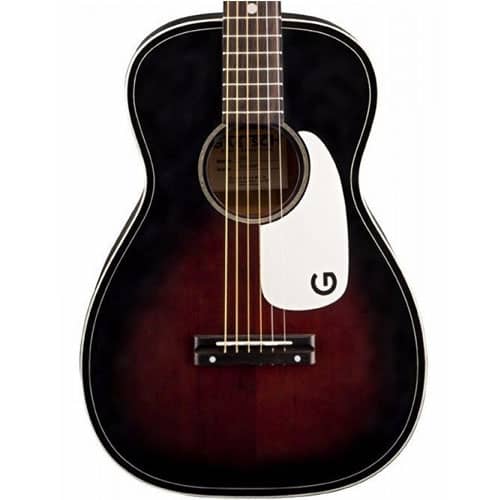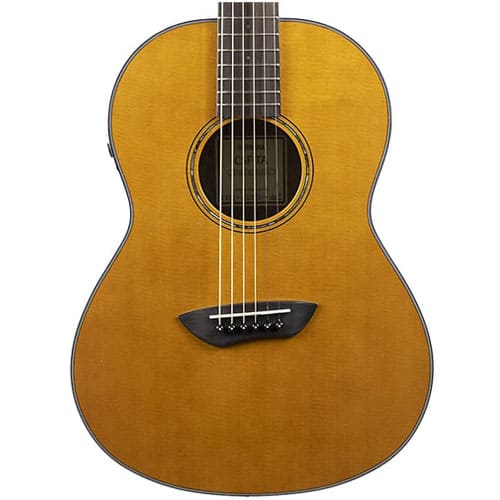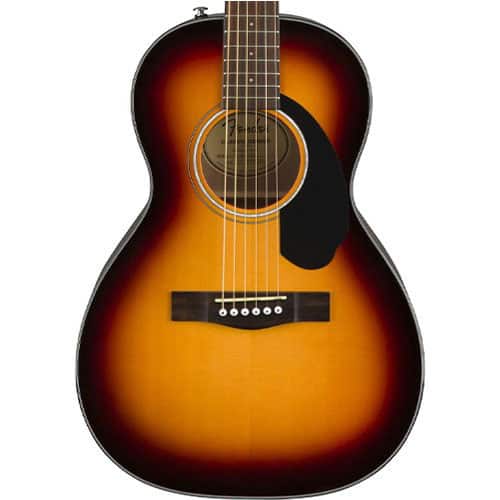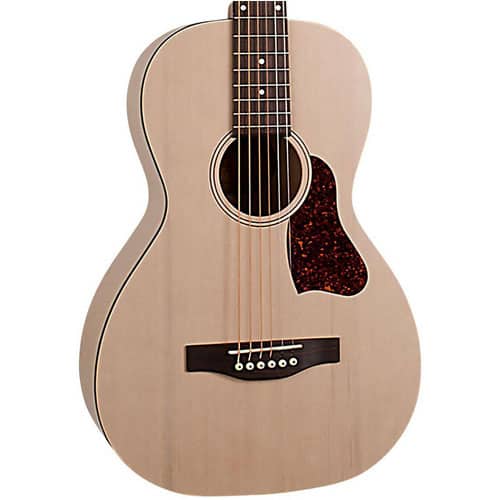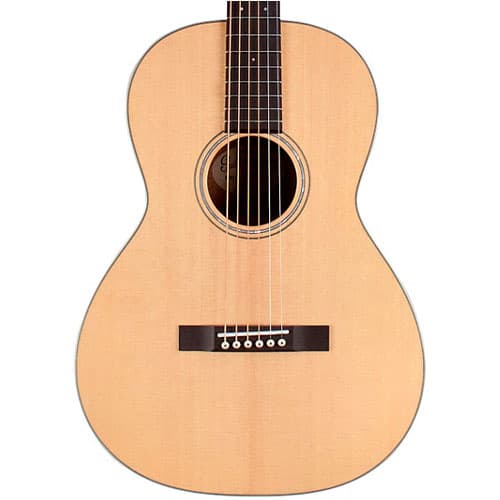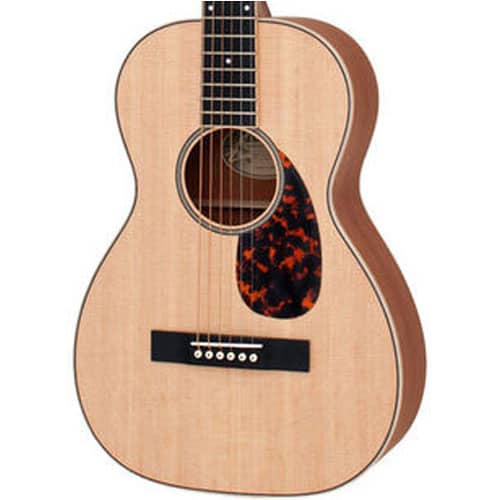Table of Contents
A comfortable body shape. Focused sound.
These are the attributes that make parlor guitars popular with guitarists the world over.
The midrange emphasis offered by parlor guitars is why many touring players and studio musicians consider them to be a “secret weapon” for recorded and live tracks alike.
One of the best parlor guitars out there — and our personal favorite — is the Taylor BT1e Baby Taylor. There’s a lot to love about this guitar. Its premium tonewoods and unique wider body gives you full-size sound in a smaller package.
The Baby Taylor isn’t the only great parlor guitar on the market, however. Our guide reviews nine of the best parlor guitars around.
So, whether you like to play blues, folk, or just mess around, picking up one of these parlors will have you sounding great in no time.
The 9 Best Parlor Guitars:
| Image | Parlor Guitar | Summary | Check Price |
|---|---|---|---|
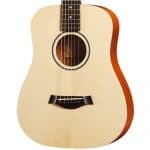 | Taylor BT1e Baby Taylor Parlor Acoustic Guitar | Best Choice: Top-notch tonewoods and unique body shape for a parlor guitar that punches well above its price | Check price |
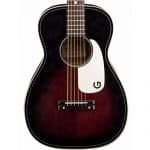 | Gretsch G9500 Jim Dandy Flat Top Parlor Acoustic Guitar | Best Value: Jam-packed with blues and country tones at an extremely affordable price | Check price |
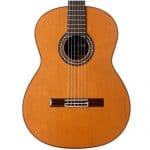 | Cordoba C9 Acoustic Guitar | Premium Pick: Merges classical style with parlor size for a great fingerpicking model | Check price |
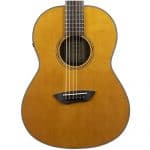 | Yamaha CSF-TA TransAcoustic Parlor Guitar | Unique Built-in Effects: Complete package in one guitar — no amplifier necessary! | Check price |
 | Fender CP-60S Parlor Acoustic Guitar | Ultra-Budget Friendly: No-nonsense budget model that delivers great parlor tone with a full-length scale | Check price |
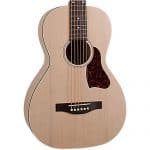 | Art & Lutherie Roadhouse Acoustic Guitar | Classic Styling: Vintage parlor tone and finishes in a sleek, sustainable package | Check price |
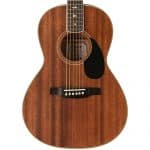 | Paul Reed Smith SE Parlor P20E | Professional-Grade Parlor Acoustic: Legendary PRS quality for a parlor frame with outstanding tone | Check price |
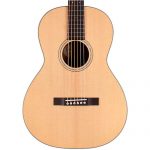 | Guild P-240 Parlor Guitar | Mid-Range Fingerpicker: Classical influences and upscale amenities with a beautiful parlor sound | Check price |
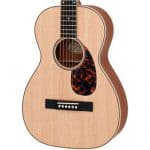 | Larrivee P-03 Parlor Guitar | Outstanding Workmanship: Custom shop build quality and tone at a fraction of the price | Check price |
Taylor BT1e Baby Taylor Parlor Acoustic Guitar
Taylor Guitars is one of the world’s most famous acoustic brands. Rather than stick to traditional styles, this company loves to innovate with both tonewoods and body shapes. The BT1e Baby Taylor is a product of that innovation.
This parlor guitar uses a solid sitka spruce top and layered walnut for the back and sides; together they provide great sustain and clarity without sacrificing depth. The neck is made from hard rock maple, with an ebony fingerboard for a snappy response and smooth, relaxed feel.
Instead of a traditional narrow body, the BT1e uses a 3/4 dreadnought shape, which adds more balance and acoustic projection. It’s a great way to balance out the sharper, mid-focused tone of most parlors. Thanks to the satin varnish finish over the body and neck, it’s also very comfortable to play.
The BT1e also includes an onboard pickup and preamp, with a built-in tuner to keep you sounding great at all times. The electronics extend the range of the instrument significantly. While it’s great as a travel guitar, plugging this guitar in lets you use it on stage as well as your bedroom.
Positives
- 3/4 dreadnought body provides distinctive vintage tone with plenty of balance and sustain
- Combination of solid sitka spruce top, ebony, and walnut create a premium feel for such an affordable guitar
Negatives
- 22.75-inch scale length makes the frets a bit smaller and more cramped than many other parlors
- Varnish finish is smooth and comfortable, but looks a bit plain for some users

Gretsch G9500 Jim Dandy Flat Top Parlor Acoustic Guitar
Gretsch might be a famous name in the electric guitar world, but that’s not all the company makes. Its Jim Dandy flat top parlor guitar faithfully recreates the sound and style of 1930s parlor guitars, with a price that modern players can afford.
This axe uses an agathis body, combined with a nato neck and walnut fretboard. While these aren’t traditional acoustic tonewoods like mahogany or spruce, they provide a lovely balanced tone with a vintage “boxy” parlor midrange.
Like most retro parlor guitars, the Jim Dandy features a 12th fret neck join and straight bridge for a slightly shorter scale. This makes the guitar more comfortable to play, particularly for beginners and young players.
You won’t need to stretch to get your fingers around the thinner neck, and the shorter scale length reduces string tension and makes notes easier to fret. If you’re looking for a vintage-style parlor guitar that’s comfortable to play and won’t break the bank, it’s hard to beat the Jim Dandy.
Positives
- Nails midrange focused pre-war parlor tone at an outstanding price
- Low action and short-scale length make it easy for all guitarists to pick up and play
Negatives
- Bass response is adequate, but a bit muted; doesn’t resonate as well in the lower register
- Acoustic projection might not be enough for strumming over a singer or crowd

Cordoba C9 Acoustic Guitar
Fans of classical guitars will recognize Cordoba as one of the premier nylon-string manufacturers on the market today. Their C9, one of their flagship guitars, provides its famous build quality and tonewood choice in a parlor size. If you’re in the market for a premium classical model with a comfortable shape, the C9 Parlor is one of the guitars you need to check out.
This parlor uses solid cedar rather than a solid spruce top, with solid wood mahogany back and sides. There’s also a solid wood mahogany neck, paired with an indian rosewood fretboard and a classical slotted headstock.
It’s shaped with a 7/8 size classical body, which is slightly wider than a traditional parlor shape and maximizes sustain and resonance.
If you like warm, nylon string tones, the C9 Parlor is for you. Its tonewood pairings emphasize the midrange and bass, with smooth and supple response and plenty of dynamic range.
It’s not the loudest guitar out there, which makes it a bit difficult for strumming, but discerning players will love how well the C9 accents their phrasing and articulation. Along with the 50mm nut width, this comes in handy for fingerstyle players.
Positives
- Solid cedar top, solid mahogany back and sides and mahogany neck provide a warm and clear tonal profile
- 7/8 classical body retains more sustain and resonance, without sacrificing comfort of a parlor
Negatives
- Nylon strings and classical guitar appointments limit the stylistic range of this parlor
- Tonewoods and strings make this guitar quieter than similar steel-string parlors

Yamaha CSF-TA TransAcoustic Parlor Guitar
This upscale model from Yamaha takes the brand’s famous build quality and tone into a wider parlor guitar body. It’s built with a solid spruce top, mahogany body, nato neck and rosewood fingerboard.
Unplugged, the CSF-TA provides a strong midrange presence, although it captures a lot of tones that you might find on a concert or dreadnought acoustic. The wider body makes the tone a lot more versatile than some other parlors you’ll find. You can use the CSF-TA for anything from strumming to fingerpicking and slide playing.
This parlor also has a few other tricks up its sleeve, in the form of onboard effects. These are built-in reverb and chorus sounds that you can use without plugging in or adding any pedals.
Rather than digital emulations, this parlor generates the effects with an actuator installed in the guitar, creating natural reverb and chorus that mix perfectly with the acoustic tone.
Of course, if you want to play live, the CSF-TA also includes an onboard piezo and preamp. This gives you the flexibility to take one parlor guitar from your home to the stage, without missing a beat.
Positives
- Wider parlor body provides a versatile tone closer to dreadnoughts and concert guitars
- Built-in reverb and chorus sound very natural and complement the acoustic tone well
Negatives
- Laminate mahogany back and sides are a bit disappointing at this price point
- Piezo pickup doesn’t provide a lot of dynamics; adds some metallic coloring

Fender CP-60S Parlor Acoustic Guitar
For players looking for a first parlor guitar, it’s hard to beat the value and tone of the Fender CP-60S parlor. This little model features a full-length scale and a solid spruce top, to keep everyone from beginners to advanced players engaged.
The solid spruce top pairs with laminate mahogany for the back and sides, giving the parlor guitar a bright, clear tone with an emphasis on the midrange and fundamentals. The solid wood top and scalloped “X” bracing increases sustain and attack, for both strumming and fingerstyle guitar players.
The neck uses laminated mahogany and a rosewood fingerboard, with rolled edges to make it comfortable and smooth to play. The 20 frets give you the dynamic range of a larger guitar with the parlor guitar size.
Along with the natural finish, the Fender CP-60S is available in a sunburst finish, which adds a bit of unique style for a parlor guitar.
Positives
- Top made from solid spruce makes this one of the best parlor guitars for the value
- Full-length scale opens up a lot more notes to play than most other parlor guitars
Negatives
- Hardware and setup are mediocre — some guitar players might want to upgrade them
- Plastic nut doesn’t provide great tone, particularly compared to bone or Tusq nuts

Art & Lutherie Roadhouse Acoustic Guitar
Canadian manufacturer Art & Lutherie makes acoustic guitars that honor the great guitar designs of past decades, while focusing on sustainability and cost for the modern day. Its Roadhouse parlor guitar looks and sounds like a guitar straight from the Depression era, at a surprisingly affordable price.
The Roadhouse uses wild Canadian cherry for its back and sides, with a solid pressure-tested spruce top and silver leaf maple neck. These tonewoods create a retro voice for the guitar, with plenty of pop for blues and folk music.
To keep your guitar sounding pristine, the Roadhouse is also equipped with a set of open-gear 16:1 brass tuners and a Graphtech Tusq nut and saddle. These hardware upgrades are rare to find in this price bracket, and they make the Roadhouse a much more durable and reliable parlor guitar to own.
Beyond the build quality and tone, it’s the finishes — bourbon sunburst, matte black and wine red — that truly set this guitar apart. If you’re looking for a parlor guitar with a unique vintage flair, you can’t top the aesthetics of the Roadhouse.
Positives
- Sloped shoulders provide midrange-heavy tone associated with parlors
- Body style and finishes capture the best aspects of vintage parlor guitars
Negatives
- Smaller body and scale aren’t as versatile as other models on the market
- No natural finish available, which many guitarists love

Paul Reed Smith SE Parlor P20E
PRS acoustics provides modern, forward-thinking designs with legendary build quality and style. Their P20E applies that legacy into an acoustic-electric parlor guitar with plenty of flair.
This guitar uses mahogany for the back and sides, with a solid slab of mahogany for the top. Besides providing a dry, punchy tone, the mahogany makes this one of the best-looking guitars you’ll find anywhere.
The ivory binding, ebony fretboard and suave herringbone rosette only add to the premium feel. But this guitar isn’t just a pretty tool for using around the house.
The built-in Fishman pickup and preamp makes the P20E useful on stage as well as at home. All you need to do is plug in, and you’re set to play however loud you want. You can make sure your sound stays perfect with the volume and tone controls in the soundhole.
Positives
- All-mahogany body adds unique look and punchy, focused tone
- PRS fit and finish makes this guitar play great right out of the box
Negatives
- Tone and volume controls are a bit difficult to reach in the soundhole
- Laminated sides and back diminish the acoustic resonance of the guitar when unplugged

Guild P-240 Parlor Guitar
The Guild P-240 merges some of the best features of classical guitars into a steel-string parlor design. The end result sounds great for fingerpicking, but also holds up well to strumming, blues and country.
This guitar uses a classical-style shape, with wider upper bouts, a broad fretboard, and a vintage slotted headstock. Beyond looking great, these features balance out the guitar’s voice: it still emphasizes mids like any parlor guitar, but it’s versatile enough to play almost any style of music beyond a traditional parlor range.
The body itself features a solid sitka spruce top, with mahogany for the back, sides and C-shape neck. There’s also a pau ferro fingerboard, which has all of the smooth, warm tone and luxurious feel of rosewood.
Speaking of luxury, the P-240 is one of the most attractive parlor guitars around. The ivory binding, mother of pearl rosette, and satin/gloss combo finish make this guitar a stunning parlor for any player who wants a premium option.
Positives
- Classical body shape and solid top provide delicate, balanced tone for all genres
- Mother-of-pearl accents and satin/gloss combo finish create a beautiful premium look
Negatives
- Larger body style might not be as comfortable as some smaller parlor guitars
- Wider nut width is a bit uncommon for a parlor guitar, and makes strumming tougher

Larrivee P-03 Parlor Guitar
It’s hard to beat the Larrivee P-03. This lavish model spares no expense, with an all-solid wood construction and plenty of tasteful amenities.
The P-03 uses solid spruce for the top, paired with solid mahogany for the rest of the body and neck and ebony for the fingerboard. The entire guitar and neck are bound in maple, for a premium look that’s refined yet still luxurious.
Along with the tonewoods, the build quality is spot-on. Every Larrivee is built by hand in the USA, to give you the best fit and finish possible.
Most importantly, the P-03 sounds just as good as it looks. The response is balanced between bass, mids and treble, with a slight emphasis on the mids and upper register. The tighter bass makes this a dream guitar for recording or playing live, where you need to cut through a mix.
Positives
- All-solid wood construction provides fantastic tone with spruce and mahogany
- Controlled, balanced profile is perfect for recording or playing live
Negatives
- Costs much more than other parlor guitars on the market
- Less bass response than larger acoustic guitar sizes

What is a Parlor Size Guitar?
A parlor size guitar is one of the smallest body shapes that you’ll find on a guitar. Parlor shapes used to be some of the most common guitars on the market, until larger models like the concert and dreadnought began to grow in popularity.
You can identify a parlor guitar by its body shape: sloped shoulders and narrow lower bouts. Parlor guitars are a lot curvier and narrower than larger acoustic guitars. The best parlor guitars are often nearly symmetrical.
They also offer smaller, shorter scale lengths than larger models. It’s common to see 15- or 16-fret necks on parlors, while most acoustics include 19 to 20 frets.
Parlor guitars are still popular for bluesy, midrange-heavy tones today. They’re usually built with more affordable tonewoods, though some manufacturers also use premium materials.
The woods used to build a parlor guitar often accent the guitar’s emphasis on the midrange. This makes parlor guitars sound a lot more “brash” or “in your face” than some other acoustics.
Spruce and mahogany are some of the most popular parlor guitar tonewoods, while it’s rarer to find models with a rosewood back. You’ll also see sapele, cherry, and agathis used to get these same tones on budget models.
Parlor Guitars vs 3/4 Size Guitars
A 3/4 size guitar might look similar to a parlor guitar, but there are a few important differences. Most 3/4 guitars usually feature wider bodies, with a longer scale length and wider nut width. They look like dreadnoughts or concert models, just shrunken down a bit.
What sets a parlor guitar apart is its body shape. Most parlors have thin, sloped shoulders and narrower bouts. Some vintage parlors have even been called “peanut” guitars because of their shape.
That different shape changes the tone of the guitar, and makes it a more specialized tool for blues and country playing.
There are also a few differences in the tonewoods used to build these guitars. Many of the 3/4 size guitars feature tonewoods that you’d see on the full-size versions; warmer tonewoods like a rosewood back and sides are more common.
Parlors prefer to emphasize the midrange and trebles, with mahogany, sapele, and cherry more common to pair with spruce.
What are Parlor Size Guitars Good For?
Thanks to their small body, parlors have a unique tone. They tend to focus on the midrange and provide a “boxy” sound. They also provide bright, clean trebles, but the bass response is a bit less than larger guitars. That’s because the smaller interior cavity prevents the big, wider reverberations that give you boomy bass sounds in larger acoustic guitars.
That makes them great for playing styles like blues and country music, or for fingerpicking in general. They’re most commonly used by solo players outside of a live band setting. Without a well-rounded tone between bass, mids and trebles, parlors can sometimes sound a bit unbalanced in a full band mix.
The best parlor guitars are particularly effective if you want to play old folk music, or solo Delta blues songs (especially with a slide). A lot of guitar music from the first half of the 20th century was recorded using parlors, which is why people often associate their distinctive sound with a “vintage” or “retro” feel.
Beyond these stylistic advantages, parlors are also great for keeping around the house or as a lightweight travel guitar. They’re much easier to fit in the trunk of a car, and their bright, midrange-heavy tone sounds great around a campfire or picnic.
A lot of players also like to keep a parlor guitar on hand in case inspiration strikes, or they just want to jam. The small shape and short, comfy scale of a parlor guitar makes them perfect tools for writing songs or playing on the couch.
Are Parlor Guitars Easier?
Many beginners find parlor guitars easier to play than larger acoustic shapes. Their thin waist and sloped shoulders make it easy for young and small players to sit down with a parlor comfortably, and the shorter scale keeps your hands within close reach of your chest.
Together, these factors make parlors a great choice for players in search of an easy-to-play guitar. There are a few drawbacks you’ll need to keep in mind as well.
The first is the neck size of parlor guitars. Parlor axes usually feature a neck with only 15 or 16 frets, in contrast to the standard 19 or 20 on larger acoustic guitars.
Most parlors are also too small to allow for cutaways, which makes it more difficult to access those upper frets. Most blues and country players don’t go above the 12th fret often on acoustic guitars. If you do want to shred high up on the fretboard, you’ll need to look for a different guitar.
Which Is The Best Parlor Guitar For Beginners?
If you’re just beginning to play guitar, a parlor guitar is a great choice. It’s important, though, to pick a model that inspires you to play and offers enough quality to help you progress.
This means that parlors with extra-short necks aren’t a great option for beginners. While they’re easy to get started on, they feel a lot different from larger acoustic and electric guitars, which can make it difficult to transition as you improve.
The best parlor guitars for beginners combine a slightly longer scale with a body that provides balanced, versatile tones. These guitars are flexible enough to play anything you want and won’t hold you back from switching to another guitar down the line.
For guitar players on a budget, check out the Taylor BT1e and the Fender CP-60S. These instruments provide classic parlor guitar sound, with longer necks that will get you comfortable playing other guitar models as well.
If you’ve got a bit more money to spend, you might also want to check out the Guild P-240. Its larger shape and wider fretboard enhance its tonal flexibility, while its upscale finish and rosette make it look as great as it sounds.
Bottom Line
For beginners and pros alike, it’s hard to beat the combination of tone and comfort parlor guitars offer.
If you’re after a professional-grade model with style to boot, the Taylor BT1e Baby Taylor has everything you need in a parlor axe. Some other options to check out include the Gretsch Jim Dandy — a favorite budget pick for blues players — and the Art and Lutherie Roadhouse.
Do you own a parlor guitar? How do you like to use it? Around the house, in the studio, or on stage? Let us know in the comments below.
